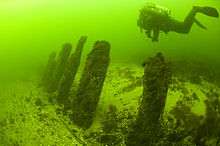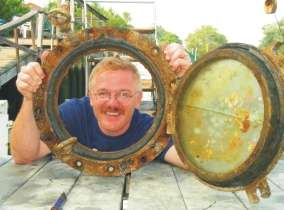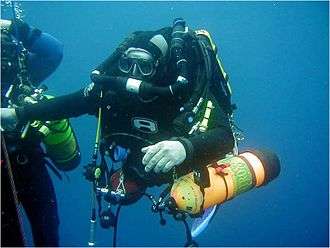Wreck diving

Wreck diving is a type of recreational diving where shipwrecks are explored. Although most wreck dive sites are at shipwrecks, there is an increasing trend to scuttle retired ships to create artificial reef sites. Diving to crashed aircraft can also be considered wreck diving.[1]
Reasons for diving wrecks
A shipwreck is attractive to divers for several reasons:[2]
- it serves as an artificial reef, which creates a habitat for many types of marine life
- it often is a large structure with many interesting parts and machinery, which is not normally closely observable on working, floating vessels
- it often has an exciting or tragic history
- it presents new skill challenges for scuba divers
- it is part of the underwater cultural heritage and may be an important archaeological resource and aviation archaeology
- it provides a first-hand insight into context for the loss, such as causal connections, geographical associations, trade patterns and many other areas, providing a microcosm of our maritime heritage and maritime history
- it sometimes contains artifacts of historical, artistic and/or monetary value, which can be sought for profit (treasure hunting) or collection purposes (ranging from rare collector's items to souvenirs, memorabilia or other "trophies", such as crew members' or passengers' personal belongings, nautical instruments, brass portholes or silverware, cutlery, intact china or other tableware).
Types of wreck diving

In his seminal work on the subject, The Advanced Wreck Diving Handbook,[3] Gary Gentile sub-divides wreck diving into three categories:
- Non-penetration diving (i.e. swimming over the wreck)
- Limited penetration diving, within the "light zone"
- Full penetration diving, beyond the "light zone"
Each subsequent level involves greater risk, and therefore will normally require greater levels of training, experience and equipment.[4]
Non-penetration wreck diving is the least hazardous form of wreck diving, although divers still need to be aware of the entanglement risks presented by fishing nets and fishing lines which may be snagged to the wreck (wrecks are often popular fishing sites), and the underlying terrain may present greater risk of sharp edges.
Penetration within the light zone presents greater hazards due to overhead and greater proximity of the wreck's structure, but because of the proximity of a visible exit point, and some amount of external light, those hazards are more manageable. However, there is clearly a much greater risk of entanglement and silt out inside of the structure, as well as the requirement to move laterally to a defined exit point before one can surface in the event of an emergency.
Full penetration involves the greatest level of risks, including the risk of getting lost within the structure, the risk of complete darkness in the event of multiple light failures, and the inability to escape unassisted in the event of a disruption to air supply.
These categorisations broadly coincide with the traditional division between "recreational" wreck diving (taught as a specialty course by recreational diver training agencies and normally limited to the "light zone" and/or 100-130 cumulative feet of depth plus penetration) and "technical" wreck diving (taught as a stand-alone course by technical diver training agencies).
Training and safety
Wrecks may pose a variety of unique hazards to divers. Wrecks are often snagged by fishing lines or nets and the structure may be fragile and break without notice. Penetration diving, where the diver enters a shipwreck is an advanced skill requiring special training and equipment.[5] Many attractive or well preserved wrecks are in deeper water requiring deep diving precautions. It is essential that at least one cutting device be carried in the event that the diver is entangled with fishing lines or ropes and to have a spare light source in case the primary light fails. If penetrating a wreck, a guideline tied off before entering a wreck and run out inside the wreck is advisable. A guideline helps a wreck diver to find the way out more easily in case of low visibility due to stirred-up sediments. For penetration diving, a greater reserve of breathing gas should be allowed for, to ensure there is sufficient to get out of the wreck. Most wreck divers use a minimum of the rule-of-thirds for gas management. This allows for 1/3 of the gas down and into the wreck, 1/3 for exit and ascent and 1/3 reserve. In addition, because of the potential fragility of the wreck, the likelihood of disturbing sediments or disturbing the many marine animals that take advantage of the artificial habitat offered by the wreck, extra care is required when moving and finning. Many divers are taught to use alternative finning methods such as frog kick or modified flutter kick when inside a wreck. Perfect buoyancy control is a must for diving in the environment of a wreck.

Penetration diving
In technical penetration diving, there are broadly two approaches. The conventional approach involves the use of continuous guidelines laid from a wreck reel, tied just outside the entrance point, just inside the entrance point, and at regular intervals inside (to mitigate the risk of a cut line, or a "line trap"[6]). In deeper penetrations, two reels are used, so that in the event of a total loss of visibility where the diver loses contact with the primary line or the primary line gets cut, the secondary line can be anchored and then used as a reference point to sweep for the primary line.
An alternative approach, popularised by deep wreck divers in the American Northeast, is referred to as "progressive penetration". Progressive penetration eschews the use of reels, but the diver makes several successive penetrations, each successively deeper than the last, memorising the layout for both the inward and outward journeys. As a diving technique, progressive penetration is not taught by any of the mainstream diver training agencies.[7]
Divers engaging in penetration diving are conventionally taught to carry three lights - a primary light and two backup lights - thereby virtually eliminating the risk of completely losing light inside the wreck. Nonetheless, total loss of visibility due to a silt-out remains a risk.
Deep diving and wreck diving

Wrecks in shallower waters tend to deteriorate faster than wrecks in deeper water due to higher biological activity. Accordingly, many of the older and larger shipwrecks that tend to offer full penetration dives tend to be deeper dives. This can present additional complications; if a wreck dive is intended to be a decompression dive, then the diver will normally carry decompression gases in side mounted cylinders. However, it is difficult to penetrate many wrecks with both back mounted and side mounted cylinders, requiring divers to either use a different configuration, or leave their decompression gases outside the wreck prior to penetration. This creates the possibility of a diver being unable to relocate their decompression gases if they exit the wreck at a different point from which they enter it.[8]
Training
Because of the increasing popularity and higher risk of wreck diving, many diver training organizations such as Scuba Diving International and the Professional Association of Diving Instructors provide specialist wreck diver training courses, which divers are advised to take before wreck diving.[9] Such courses [5] typically teach skills such as air management and the proper use of guidelines and reels. Most recreational diving organizations teach divers only to penetrate to at most the limit of the "light zone" or a maximum aggregate surface distance (depth and penetration) of 100 feet. Other technical diving organizations, such as IANTD, TDI and ANDI teach advanced wreck courses that emphasize a higher level of training, experience and equipment and prepare divers for deeper levels of wreck penetration. The Nautical Archaeology Society in the UK, teaches awareness of underwater cultural heritage issues as well as practical diver and archaeological skills. Other organizations, such as the Artificial Reef Society of British Columbia (ARSBC) deliberately create artificial reefs to provide features for divers to explore, as well as substrates for marine life to thrive upon.
Protection of wrecks
In many countries, wrecks are legally protected from unauthorized salvage or desecration.
In the United Kingdom, three Acts protect wrecks:
- Protection of Wrecks Act 1973 : certain designated, charted, historic or dangerous sites may not be dived without a license
- Protection of Military Remains Act 1986 : all military aircraft and 16 designated ships are considered war graves that can only be dived with a license. Other non-designated ships may be dived providing the divers do not enter, disturb or remove artifacts
- Merchant Shipping Act 1995 : all wrecks and cargoes are owned: each artifact removed must be reported to the Receiver of Wreck
Wrecks that are protected are denoted as such on nautical charts (such as admiralty charts); any diving restrictions should be adhered to. Historic wrecks (often but not always defined as being more than 50 years of age) are often protected from pillaging and looting through national laws protecting cultural heritage.[10] Internationally they may be protected by a State ratifying the Unesco Convention on the Protection of the Underwater Cultural Heritage. In this case pillaging is not allowed. One such example is the Queen Anne's Revenge[11] which is undergoing archaeological recovery by the North Carolina Department of Natural and Cultural Resources (NC DNCR) near Beaufort Inlet, NC.
In Greece, during the year 2003 the Greek Government (ministry of culture), issued a Ministerial Order classifying "any wreck of ship or aeroplane, sunk for longer than 50 years from the present" as Cultural Assets / Monuments, setting also a protection zone of 300 meters around them. Terms and conditions for visiting any monument in Greece are set by the Ministry of Culture in Greece.
Wreck diving sites
There are thousands of popular wreck diving sites throughout the world.[12] Some of these are artificial wrecks or sunk deliberately to attract divers (such as the USS Spiegel Grove and the USS Oriskany in Florida, the Bianca C in Grenada, and the wrecks of Recife in Pernambuco/Brazil which include artificial and disaster wrecks). Diver trails also called wreck trails can be used to allow scuba-divers to visit and understand archaeological sites that are suitable for scuba-diving.[13] One excellent example is the Florida Public Archaeology Network's (FPAN) "Florida Panhandle Shipwreck Trail."[14]
Along the Outer Banks, navigational challenges posed by the Diamond Shoals area off Cape Hatteras, caused the loss of thousands of ships and an unknown number of human lives. More than 5000 ships have sunk in these waters since record keeping began in 1526.[15] Among the better known shipwrecks was the USS Monitor,[16] a participant in the famous Battle of Hampton Roads during the American Civil War. The Monitor foundered and sank on 31 December 1862 off Cape Hatteras. During World War II German U-boats would sit offshore and silhouette passing freighters and tankers against the lights onshore. Dozens of ships along the North Carolina coast were torpedoed in this fashion by German submarines in what became known as Torpedo Alley. Popular wrecks include the German submarine U-352, USS Monitor, USS Schurz (SMS Geier), USS Tarpon, USS Yancey, USS Indra, USS Aeolus and USCGC Spar.[17]
Others are wrecks of vessels lost in disasters (such as the RMS Rhone in the British Virgin Islands, the Zenobia in Cyprus and the many shipwrecks off the Isles of Scilly in England). In the Marlborough Sounds, New Zealand, the wreck of the MS Mikhail Lermontov, a 177-meter cruise liner which was lost in 1986, is a popular dive site. Lying at 37 meters underwater, this wreck is an excellent base for recreational and technical divers.[18][19]
More unusual wrecks are unintended structures, such as the wreck of the old cruise ship pier in Saint Croix, U.S. Virgin Islands, destroyed by Hurricane Hugo in 1989. As part of the recovery and replacement of the Frederiksted Pier, the old pier was removed and intended to be sunk far out at sea in 12,000' deep waters. Much of the old pier was used to create an artificial reef. Several barges carried the wreckage of the old pier two miles down the beach, dumping the wreckage, steel girders, vehicles, cement tubes, pylons, and pavement into 110' deep waters to a dive site now known as Armageddon.[20]
In the Andaman Islands, the Inket Wreck, where a Japanese ship sank during WW II is a dive site near Duncan Island. The bow rests on its starboard side with hatches and cargo hold clearly visible. An enormous propeller sits upright in 18m of water; and parts of the boilers and engine room are intact along with a second, spare propeller. Coral encrusts the ship’s skeleton, scorpionfish, butterfly fish, trevallies, fusiliers, damsel fish and sea anomone with clownfish are abundant. The 2004 tsunami straightened out the 70-meter wreck that had been lying on its side. This dive site is ideal for advanced divers, but sometimes conditions are suitable for beginner-level divers.
A number of the most enigmatic wreck diving sites relate to ships lost to wartime hostilities, such as the SS Thistlegorm in the Red Sea, the wrecks of Subic Bay and Coron, in the Philippines, SS President Coolidge in Vanuatu and the "ghost fleet" of Truk Lagoon.
In the Encyclopedia of Recreational Diving, four "Meccas" of wreck diving are identified: (1) Truk Lagoon in Micronesia, (2) Scapa Flow in Orkney Islands, Scotland, (3) the Outer Banks of North Carolina (known as the "Graveyard of the Atlantic"), and (4) the Great Lakes.[21]
For technical divers there are fewer wrecks that have attracted widespread popularity, although for years the SS Andrea Doria was regarded as the "Mount Everest" of wrecks to challenge the diver. However, since the popularisation of trimix as a breathing gas, technical divers now routinely dive much deeper and more challenging wrecks, and the Andrea Doria is argued by some to now be a good training wreck for trimix divers.[22] Trimix is also used to visit the USS Monitor and wrecks in Marlborough Sounds, New Zealand (MS Mikhail Lermontov), as well as in Brazil at Recife,[23] and Fernando de Noronha (Corveta Ipiranga, where technical diving is available).[24]
See also
- Archaeology of shipwrecks
- Aviation archaeology
- Diver training
- List of shipwrecks
- Maritime archaeology
- Michigan Underwater Preserves
- Nautical Archaeology Society
- Marine salvage
- Scuba diving
- Shipwrecks
- Sinking ships for wreck diving sites
- Underwater archaeology
- Zenobia wreck
References
- ↑ Canadian Harvard Aircraft Association Dive Recovery Team Archived September 8, 2012, at the Wayback Machine.
- ↑ - Wreck Diving Explained
- ↑ ISBN 978-1-883056-29-2, at page 75
- ↑ "Basic wreck diving vs. Advanced wreck diving". Technical Diving International. 2012-08-06. Retrieved 2012-08-07.
- 1 2 - PADI Wreck Diver training and qualifications
- ↑ A line trap refers to the situation where a line is laid between two points, but when taut, the line stretches through a narrower opening which the diver cannot swim through. With visibility this is not a problem as the diver can retrace his original route; but with a complete loss of visibility the diver would be unable to follow the line by touch alone back to the exit point.
- ↑ The largest technical diver training organisation, TDI, traditional takes an open-minded and inclusive approach to different techniques. Notwithstanding this general principal, the TDI Advanced Wreck Diving manual describes progressive penetration as a "fairy tale method" (at page 26).
- ↑ In 1992 two divers, Chris and Chrissy Rouse, died of decompression sickness after becoming trapped in the wreck whilst diving German submarine U-869 off the New Jersey coast, and then being unable to relocate their decompression gases after they escaped. The incident became famous after being chronicled in various books, including the New York Times best-selling book, Shadow Divers.
- ↑ "Wreck Diving Safety Considerations". Latest Waikiki Scuba Dive Report. Kaimana Divers. Retrieved 6 March 2016.
- ↑ "BBC Radio World Service Broadcast, "What Lies Beneath" First broadcast Friday 22 August 2008". Bbc.co.uk. 2008-08-22. Retrieved 2009-09-19.
- ↑ "Blackbeard's Flagship - Archaeology Magazine Archive". Archive.archaeology.org. Retrieved 2015-09-17.
- ↑ "Wrecks and Obstructions Database". NOAA.
- ↑ e.g. Souter, C., 2006 Cultural Tourism and Diver Education. In Maritime Archaeology: Australian Approaches. The Springer Series in Underwater Archaeology. Staniforth, M. & Nash, M. (eds) Springer, New York.
- ↑ "Florida Panhandle Shipwreck Trail". Florida Panhandle Dive Trail.
- ↑ Grussing, Valerie J. "Reanimating the Graveyard: Heritage Tourism Development of North Carolina Shipwrecks" (PDF). thescholarship.ecu.edu. Retrieved 18 July 2015.
- ↑ "Monitor NMS - The Monitor Collection". Monitor.noaa.gov. 2003-07-26. Retrieved 2015-09-17.
- ↑ Hudy, Paul. "North Carolina Shipwrecks". nc-wreckdiving.com. Retrieved 15 July 2015.
- ↑ Mouli and Tika Greenlaw (1986-02-16). "Wreck Diving in the Marlborough Sounds New Zealand". Godive.co.nz. Retrieved 2013-04-22.
- ↑ "Mikhail Lermontov - The New Zealand Maritime Record - NZNMM". Nzmaritime.co.nz. Retrieved 2013-04-22.
- ↑ "Dive Armageddon, St. Croix 2011". YouTube. 2013-12-22. Retrieved 2015-09-17.
- ↑ In his book, Wreck Diving Adventures, author Gary Gentile says: "I cannot state too often, the Great Lakes have the finest wreck diving the world."
- ↑ An excellent discussion of this is to be found in Kevin McMurray's book, Dark Descent, ISBN 0-7434-0063-1. He discusses how some older divers react poorly to use of the Andrea Doria as a training wreck, perceiving it as diminishing their achievements.
- ↑ www.Aquaticos.com.br
- ↑ www.AtlantisDivers.com.br/transicao.html
External links
| Wikivoyage has a travel guide for Wreck diving. |
- Advanced Wreck Diving Techniques
- WRECKSITE Worldwide free database of + 65.000 wrecks with history, maritime charts and GPS positions (English) (German) (French) (Dutch)
- NOAA Wrecks and Obstructions Database
- Sea Research Society
- Dangers of Wreck Diving
- Wreck Diving in the Graveyard of the Atlantic

